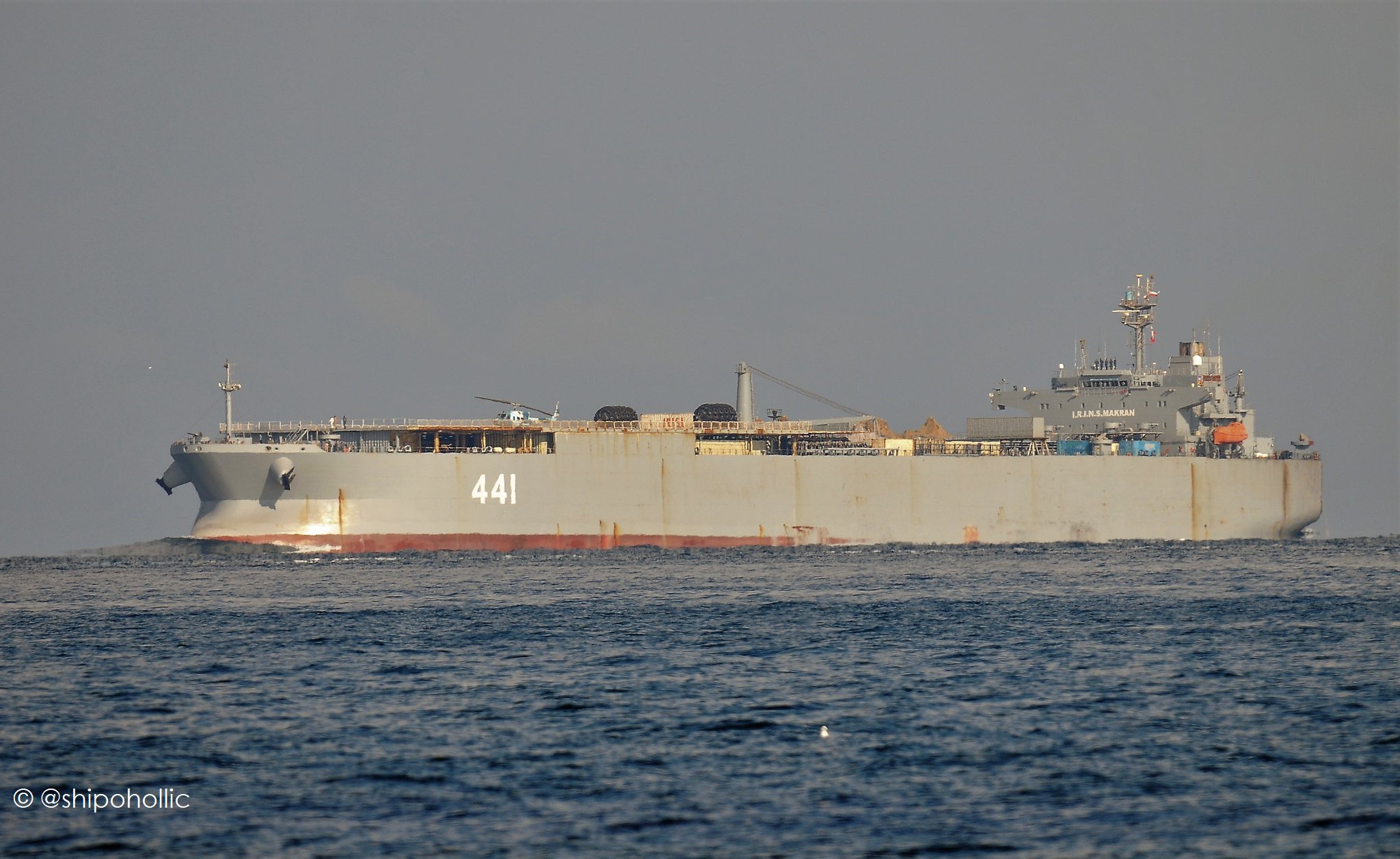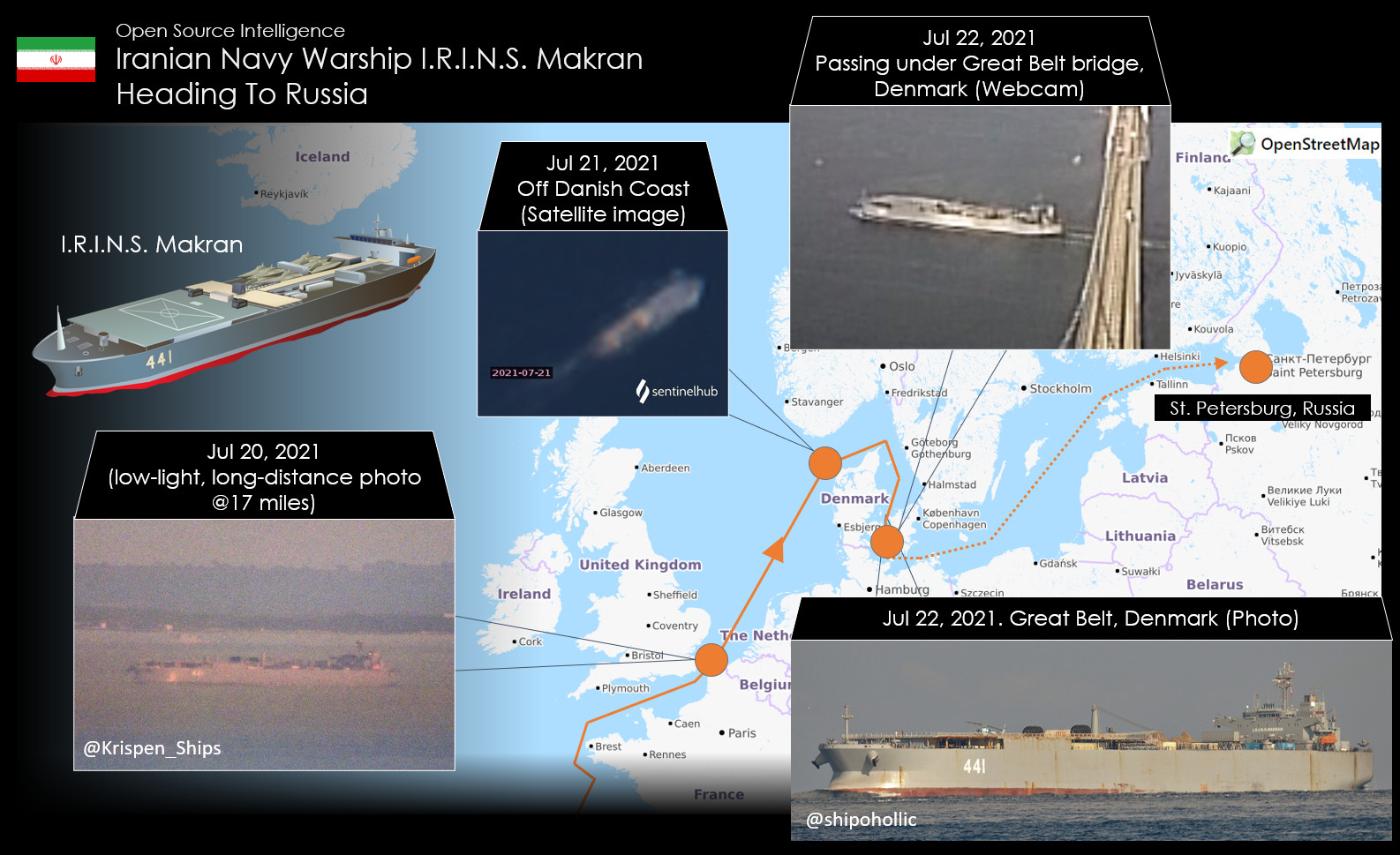
This post has been updated with additional information from the Danish Armed Forces.
Iran’s largest warship is now in the Baltic Sea – a first for the Iranian Navy – according to photos from ship spotters provided to USNI News.
Oil-tanker-turned-warship IRINS Makran transited the Great Belt early Thursday morning entering the Baltic Sea under escort by Royal Danish Navy patrol vessels.
Makran passed under the Great Belt Bridge just outside the entrance to the Baltic Sea at 6:53 a.m. local time – 2:53 a.m. EDT, according to a Thursday tweet from TankerTrackers.com. The warship was being escorted by patrol ship HDMS Diana (P250), according to AIS data from MarineTraffic.com.
Photos provided to USNI News from ship spotter @shipoholic show that Makran still has Fast Attack Craft strapped to the deck as originally reported by USNI News in June.
Frigate IRINS Sahand entered the Baltic Sea earlier via a different route, as reported by the Danish Armed Forces. Danish press reported Iranian officials notified Copenhagen the two ships would be transiting Danish waters en route to Russia.

“It’s always exciting when we get ships passed that are not everyday events. I cannot remember seeing Iranian warships in Danish waters,” Royal Danish Navy spokesman Per Hansen told newspaper Jyllands-Posten in Danish. “We will of course sail them out nicely and greet them when they come by. The same applies to the Russian submarines that we have seen in Danish waters this summer. ”
The two ships are set to represent Iran in a naval parade in St. Petersburg celebrating the 325th anniversary of the Russian Navy, according to a July statement from the Kremlin.
U.S. officials originally thought the ships were heading for Venezuela as part of the deepening relationship between Tehran and Caracas. Makran and Sahand have proceeded slowly around Africa, lingering off the coast of Senegal before crossing the Bay of Biscay and the English Channel before entering the Baltic Sea.
The move could be a sign of wider-ranging future operations, Behnam Ben Taleblu, an Iran expert at the Foundation for the Defense of Democracies, told USNI News on Thursday.
“No doubt, as the Makran and Sahand made their way to the English Channel, NATO countries perked up. It’s not every day that the Artesh [Iranian] Navy makes such a journey, and it could be [a] harbinger of increased Iranian interest in improving its maritime capabilities and testing range limits,” he said.
.@forsvaretdk følger rutinemæssigt to iranske krigsskibe i dansk farvand. Det drejer sig om det ombyggede tankskib MAKRAN ved Femern Bælt og fregatten SAHAND ved Bornholm. Det forventes, at de er på vej til den årlige flådeparade i Sankt Petersborg. #dkforsvar Foto: Flyvevåbnet pic.twitter.com/wlvdpaeS2f
— Forsvaret (@forsvaretdk) July 22, 2021
Billed as a mobile expeditionary base that can act as a lily pad for small boats, helicopters and unmanned aircraft, Makran may also allow Iran to sidestep U.S. sanctions by transporting petroleum under the flag of a warship.
Some believed Makran transited the Atlantic to sell the Maduro regime millions of gallons of refined fuel and attack craft. Venezuela, also under U.S. sanctions, has plenty of crude oil but lacks the refining capability to turn it into gas.
In 2020, four commercial tankers with Iranian gas bound for Venezuela were interdicted by U.S. authorities, and in 2019 the mega-tanker Grace 1 was seized on the behalf of American authorities. Transferring gas under the guises of a naval auxiliary would legally prevent interdiction by law enforcement and coast guards, international law experts have told USNI News.
“Iranian oil has been transported on tankers that travel across the world. Iran’s Artesh Navy simply hasn’t made these sorts of journeys in the past. Hence the concerns over the Makran, a converted oil tanker and now Iran’s largest naval vessel, over incrementally improving Iran’s seafaring capabilities for military purposes,” Taleblu told USNI News.
“Iranian media has previously touted the storage capability of the Makran, as well as its ability to house drones that could threaten enemy bases that lay outside the range of Iran’s ballistic missiles.”





